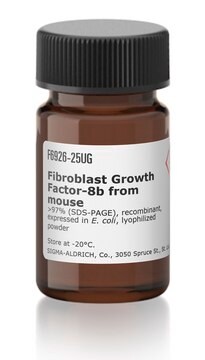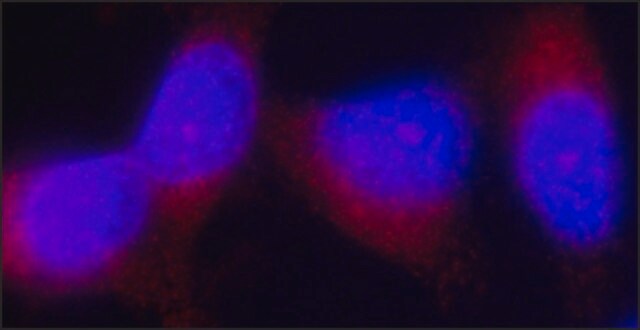SRP3144
PLGF-3 human
recombinant, expressed in E. coli, ≥95% (SDS-PAGE), ≥95% (HPLC), suitable for cell culture
Synonym(s):
PGFL, Placenta Growth Factor-3
Sign Into View Organizational & Contract Pricing
All Photos(1)
About This Item
UNSPSC Code:
12352202
Recommended Products
biological source
human
recombinant
expressed in E. coli
Assay
≥95% (HPLC)
≥95% (SDS-PAGE)
form
lyophilized
potency
5.0-50.0 ng/mL
mol wt
45.7 kDa
packaging
pkg of 25 μg
technique(s)
cell culture | mammalian: suitable
impurities
<0.1 EU/μg endotoxin, tested
color
white
UniProt accession no.
shipped in
wet ice
storage temp.
−20°C
Gene Information
human ... PGF(5228)
Related Categories
General description
PLGF (placental growth factor), originally identified in human placenta, is a member of the VEGF (vascular endothelial growth factor) family. This protein is predominantly expressed in placenta, and also shows expression in heart, thyroid, lung and skeletal muscle. It is alternatively spliced to produce four isoforms in humans namely, PLGF1, PLGF2, PLGF3 and PLGF4. PLGF gene is localized to human chromosome 14q24, spans 800kb and is composed of seven exons.
Recombinant human PlGF-3 is a 45.7kDa disulfide-linked homodimeric protein of two 203 amino acid polypeptide chains.
Recombinant human PlGF-3 is a 45.7kDa disulfide-linked homodimeric protein of two 203 amino acid polypeptide chains.
Biochem/physiol Actions
PLGF (placental growth factor) is involved in angiogenesis, but does not play an essential role in angiogenesis during reproduction and development. However, inactivation of this gene in pathological conditions such as, ischemia, inflammation and cancer, results in impaired angiogenesis. Preclinical studies show that this protein might be a therapeutic target for treatment of angiogenesis and inflammation related disorders. In acute coronary syndrome (ACS) patients, increased levels of PLGF are linked with obstructive sleep apnea (OSA) and short-term adverse outcomes.
Sequence
LPAVPPQQWA LSAGNGSSEV EVVPFQEVWG RSYCRALERL VDVVSEYPSE VEHMFSPSCV SLLRCTGCCG DENLHCVPVE TANVTMQLLK IRSGDRPSYV ELTFSQHVRC ECRHSPGRQS PDMPGDFRAD APSFLPPRRS LPMLFRMEWG CALTGSQSAV WPSSPVPEEI PRMHPGRNGK KQQRKPLREK MKPERCGDAV PRR
Physical form
Lyophilized with no additives.
Reconstitution
Centrifuge the vial prior to opening. Reconstitute in water to a concentration of 0.1-1.0 mg/ml. Do not vortex. This solution can be stored at 2-8°C for up to 1 week. For extended storage, it is recommended to further dilute in a buffer containing a carrier protein (example 0.1% BSA) and store in working aliquots at -20°C to -80°C.
Storage Class Code
11 - Combustible Solids
WGK
WGK 3
Flash Point(F)
Not applicable
Flash Point(C)
Not applicable
Certificates of Analysis (COA)
Search for Certificates of Analysis (COA) by entering the products Lot/Batch Number. Lot and Batch Numbers can be found on a product’s label following the words ‘Lot’ or ‘Batch’.
Already Own This Product?
Find documentation for the products that you have recently purchased in the Document Library.
Impact of Obstructive Sleep Apnea on the Levels of Placental Growth Factor (PlGF) and Their Value for Predicting Short-Term Adverse Outcomes in Patients with Acute Coronary Syndrome.
Barcelo A et al
PLoS ONE, 11(3), e0147686-e0147686 (2016)
PlGF: a multitasking cytokine with disease-restricted activity.
Dewerchin M et al
Cold Spring Harbor Perspectives in Biology, 2(8)-2(8) (2012)
Placental growth factor and its receptor, vascular endothelial growth factor receptor-1: novel targets for stimulation of ischemic tissue revascularization and inhibition of angiogenic and inflammatory disorders.
Autiero M, et al.
Journal of Thrombosis and Haemostasis, 1(7), 1356-1370 (2003)
Wen Yang et al.
Journal of reproductive immunology, 60(1), 53-60 (2003-10-22)
Placenta growth factor (PlGF), a homodimeric glycoprotein that is homologous to vascular endothelial growth factor (VEGF), is mitogenic to endothelial cells and protects trophoblast from apoptosis. Alternative splicing of mature mRNA gives rise to three known isoforms of PlGF. PlGF
Our team of scientists has experience in all areas of research including Life Science, Material Science, Chemical Synthesis, Chromatography, Analytical and many others.
Contact Technical Service




